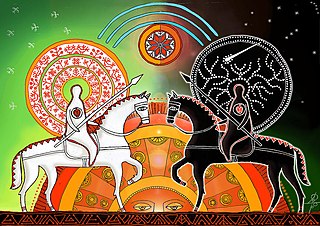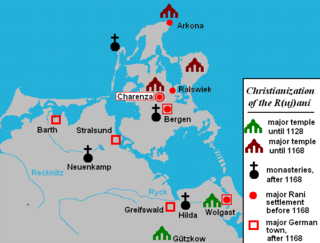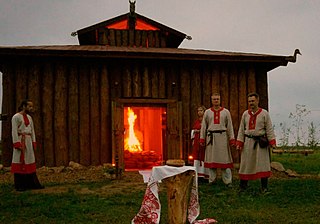Vineta is the name of a mythical city at the southern coast of the Baltic Sea. The myth evolved around the tradition about the medieval emporium called Jumne, Jomsborg, Julin or similar names by the chronicles.

Chernobog and Belobog are an alleged pair of Polabian deities. Chernobog appears in the Helmold's Chronicle as a god of misfortune worshipped by the Wagri and Obodrites, while Belobog is not mentioned – he was reconstructed in opposition to Chernobog. Both gods also appear in later sources, but they are not considered reliable. Researchers do not agree on the status of Chernobog and Belobog: many scholars recognize the authenticity of these theonyms and explain them, for example, as gods of good and evil; on the other hand, many scholars believe that they are pseudo-deities, and Chernobog may have originally meant "bad fate", and later associated with the Christian devil.

Slavic mythology or Slavic religion is the religious beliefs, myths, and ritual practices of the Slavs before Christianisation, which occurred at various stages between the 8th and the 13th century. The South Slavs, who likely settled in the Balkan Peninsula during the 6th–7th centuries AD, bordering with the Byzantine Empire to the south, came under the sphere of influence of Eastern Christianity, beginning with the creation of writing systems for Slavic languages in 855 by the brothers Saints Cyril and Methodius and the adoption of Christianity in Bulgaria in 864 and 863 in Great Moravia. The East Slavs followed with the official adoption in 988 by Vladimir the Great of Kievan Rus'.

Dazhbog, alternatively Daždźbok, Dažbog, Dazhdbog, Dajbog, Daybog, Dabog, Dazibogu, or Dadzbóg, was one of the major gods of Slavic mythology, most likely a solar deity and possibly a cultural hero. He is one of several authentic Slavic gods, mentioned by a number of medieval manuscripts, and one of the few Slavic gods for which evidence of worship can be found in all Slavic tribes.

Svarog is a Slavic god of fire and blacksmithing, who was once interpreted as a sky god on the basis of an etymology rejected by modern scholarship. He is mentioned in only one source, the Primary Chronicle, which is problematic in interpretation. He is presented there as the Slavic equivalent of the Greek god Hephaestus. The meaning of his name is associated with fire. He is the father of Dazhbog and Svarozhits.

Svetovit, Sventovit, Svantovit is the god of abundance and war, and the chief god of the Slavic tribe of the Rani, and later of all the Polabian Slavs. His organized cult was located on the island of Rügen, at Cape Arkona, where his main temple was also located. According to the descriptions of medieval chroniclers, the statue representing this god had four heads, a horn and a sword, and to the deity himself were dedicated a white horse, a saddle, a bit, a flag, and eagles. Once a year, after the harvest, a large festival was held in his honor. With the help of a horn and a horse belonging to the god, the priests carried out divinations, and at night the god himself rode a horse to fight his enemies. His name can be translated as "Strong Lord" or "Holy Lord". In the past it was often mistakenly believed that the cult of Svetovit originated from St. Vitus. Among scholars of Slavic mythology, Svetovit is often regarded as a Polabian hypostasis of Pan-Slavic god Perun. His cult collapsed in 1168.

The Veleti, also known as Wilzi, Wielzians, and Wiltzes, were a group of medieval Lechitic tribes within the territory of Hither Pomerania, related to Polabian Slavs. They had formed together the Confederation of the Veleti, a loose monarchic confederation of the tribes. Said state existed between the 6th and 10th centuries, after which, it was succeeded by the Lutician Federation.

Radogost is, according to medieval chroniclers, the god of the Polabian Slavs, whose temple was located in Rethra. In modern scientific literature, however, the dominant view is that Radogost is a local nickname or a local alternative name of the solar god Svarozhits, who, according to earlier sources, was the chief god of Rethra. Some researchers also believe that the name of the town, where Svarozhits was the main deity, was mistakenly taken for a theonym. A popular local legend in the Czech Republic is related to Radogost.

Reric or Rerik was one of the Viking Age multi-ethnic Slavic-Scandinavian emporia on the southern coast of the Baltic Sea, located near Wismar in the present-day German state of Mecklenburg-Vorpommern Reric was established probably in 735 shortly after Slavs of the Obodrite tribe had started to settle the region. At the turn of the 9th century, the citizens of Reric allied with Charlemagne, who used the port as part of a strategic trade route that would avoid areas of Saxon and Danish control. It was destroyed in 808 AD by the Viking (danish) king Gudfred. The destroyed place was rebuilt by the Obodrites and continued to operate for a short until Drasco was murdered in Reric in 810 at the instigation of Gudfred. After that, the tradespeople were reportedly moved by the king to the Viking emporium of Hedeby near modern Schleswig.

Wolin is a town in northwestern Poland, situated on the southern tip of the Wolin island off the Baltic coast of the historic region of Western Pomerania. The island lies at the edge of the strait of Dziwna in Kamień County, West Pomeranian Voivodeship.

The Rani or Rujani were a West Slavic tribe based on the island of Rugia (Rügen) and the southwestern mainland across the Strelasund in what is today northeastern Germany.
The Nakonids were the leading noble family of the Slavic peoples of the Elbe River from ca. 960 until 1129. They were themselves of Obotrite origin and engineered the formation of a Slavic principality in the region. They became extinct in the male line in the early 12th century. Their capital was Mecklenburg Castle.

Pomerania during the Early Middle Ages covers the History of Pomerania from the 7th to the 11th centuries.

The Lutici or Liutizi were a federation of West Slavic Polabian tribes, who between the 10th and 12th centuries lived in what is now northeastern Germany. Four tribes made up the core of the federation: the Redarians, Circipanians (Circipani), Kessinians and Tollensians (Tholenzi). At least in part, the Lutici were a continuation of the Veleti. In contrast to the former and the neighboring peoples, the Lutici were not led by a Christian monarch or duke, rather power was asserted through consensus formed in central assemblies of the social elites, and the Lutici worshipped nature and several deities. The political and religious center was Radgosc.

In Slavic mythology, Perun is the highest god of the pantheon and the god of sky, thunder, lightning, storms, rain, law, war, fertility and oak trees. His other attributes were fire, mountains, wind, iris, eagle, firmament, horses and carts, and weapons. He was first associated with weapons made of stone and later with those of metal.

Yarovit, Iarovit is a Polabian god of war, worshipped in Vologošč (Circipanians) and Hobolin. Sources give only a brief description of his cult, his main temple was located in Vologošč, where there was a golden shield belonging to Yarovit. By one Christian monk he was identified with the Roman Mars.

Svarozhits, Svarozhich is a Slavic god of fire, son of Svarog. One of the few Pan-Slavic gods. He is most likely identical with Radegast, less often identified with Dazhbog.

A zhrets is a priest in the Slavic religion whose name literally means "one who makes sacrifices". The name appears mainly in the East and South Slavic vocabulary, while in the West Slavs it is attested only in Polish. Most information about the Slavic priesthood comes from Latin texts about the paganism of the Polabian Slavs. The descriptions show that they were engaged in offering sacrifices to the gods, divination and determining the dates of festivals. They possessed cosmological knowledge and were a major source of resistance against Christianity.

Hennil or Bendil is an alleged agrarian Slavic god worshipped by the Polabian Slavs. He was mentioned by Bishop Thietmar in his Chronicle as a god who was represented by a staff crowned by a hand holding a ring, which is interpreted as a symbol of fertility. However, there is no general consensus on the authenticity of the deity.
















